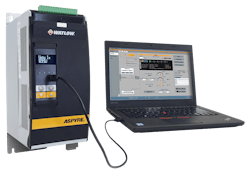A smart power controller does what it says on the tin. It is smart because it has a microprocessor and sophisticated programming. It controls power using sensors that monitor voltage and current, adapting and making decisions as conditions change within the parameters of the application that it’s being used. However, it’s a valuable tool that is often overlooked.
There are many types of power switches that are used in commercial and industrial applications. Mechanical relays and contactors are ideal for applications where they are not switched very often because they are relatively inexpensive and do not produce much heat. But for precise control of electric heating, these switch types are a poor choice because they wear out and fail quickly if switched frequently. In this instance, smart power controllers are a sensible choice.
Improved Performance
Being able to control the output based on the measurement of the power delivered to the load improves temperature control performance because it compensates for line voltage fluctuations or even partial load failures faster. This means that there is significantly less deviation from the temperature set point than would occur with the same temperature controller paired with a traditional solid-state power switching product.
The temperature controller and power controller work together. The temperature controller measures the temperature with a sensor and determines how much of the available power is necessary to achieve the set point. The power controller interprets the output from the temperature controller and controls the delivered power accordingly. Finally, the power controller adjusts the power delivered for voltage fluctuations and to the best of its ability when there is a partial failure of the heater.
Process and Equipment Characterization
The smart power controller measures the line voltage and the current through the load. With that information, it calculates the load resistance and how much power is being delivered by the heater. Equipment manufacturers can use this information during commissioning to identify if there is a problem. For example, abnormally high resistance could indicate a poor connection that might eventually cause a premature failure or even a fire if not corrected.
For instance, power controllers can help companies monitor the load parameters during equipment installation and compare the profile with previous known good start-ups. By doing this, they can receive warnings of issues localized to the heated zone, allowing preventative action to be taken before a failure occurs.
End users can similarly monitor these parameters over time and correlate them to good and bad production results.
Integrated Communication
Integrating a smart power controller with other automation equipment allows process variables to be monitored remotely and allows operators and line maintenance personnel to quickly locate problems.
Consider this example, from a Watlow customer. A manufacturer of power transmission cables once relied on employees to periodically check the current gauges visually for each zone of extruders that coat the cables. On shifts with lower staffing, the faulty product was often the first indication of a problem. The customer replaced the solid-state power controllers in the extruders with the ASPYRE DT power controllers from Watlow, so they could determine if the cable needed to be scrapped or whether production could continue until the scheduled maintenance.
Watlow’s range of heating equipment, including its ASPYRE controllers, is frequently used by heavy-duty industrial companies in petrochemicals, heat treatment, and power generation. The ASPYRE model is available between a range of 35 to 2,100 amps to support a wide variety of applications. For example, a single high amp ASPYRE unit is ideal for applications using multiple small units with low range amps.
Overall, the smart features and functionality of smart power controllers enable users to minimize scrap and unscheduled downtime—improving operations and output.












